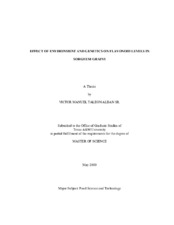| dc.description.abstract | Sorghum flavonoids have antioxidant, anti-inflammatory and anti-cancer properties and potential as natural colorants in foods. Sorghums with pigmented pericarp have high levels of flavonoids, especially 3-deoxyanthocyanins, flavanones and flavones. The effect of environment on flavonoid levels in sixteen sorghum genotypes grown in four locations in Texas (Corpus Christi, College Station, Halfway, and Weslaco) was evaluated. Sorghums from Halfway were grown at lower temperatures and the grains were more weathered than grains in the other three locations, which affected flavonoid levels, flavonoid profile, antioxidant activity, color and hardness of the grain. In general, 3-Deoxyanthocyanin levels were higher in black sorghums (151.6 - 1047.5 microgram/g) while flavanones and flavones were higher in two yellow sorghums (308.8 - 1823.1 microgram/g) and red sorghum 99LGWO50 (144.9 ? 394.0 mircrogram/g), respectively. Among locations, black sorghums at Halfway had lower levels of 3-deoxyanthocyanins (292.1 microgram/g), but red and yellow sorghums had higher levels (100.4 and 37.2 microgram/g, respectively). Flavanone levels in black and yellow sorghums at Halfway (77.9 and 525.7 microgram/g, respectively) were lower than those from the other three locations. Weathered black sorghum from Halfway had lower flavone levels than those grown in other locations (11.1 microgram/g) while in the red 99LGWO50, the levels were higher in Halfway (246.8 microgram/g). For all flavonoids, there was a genotype by environment interaction (p < 0.001), which suggested that environment had a different effect on flavonoid levels depending on the genotype. Environment, especially weathering, affected flavonoid levels and profile of sorghums which had an impact in color; hardness of the grain also was affected by environmental conditions. Evaluation of the effects of these changes in processing of sorghum foods is necessary. | en |


